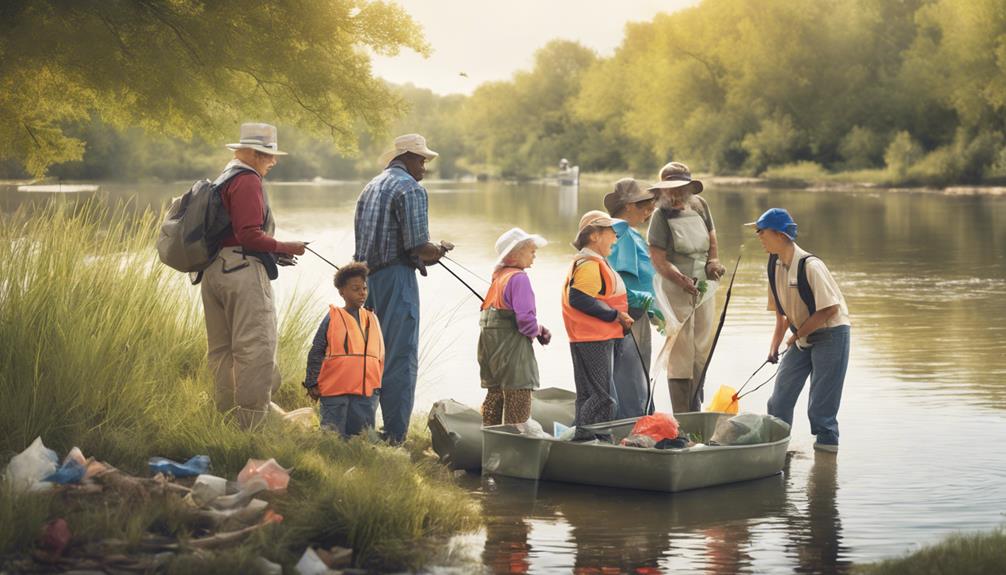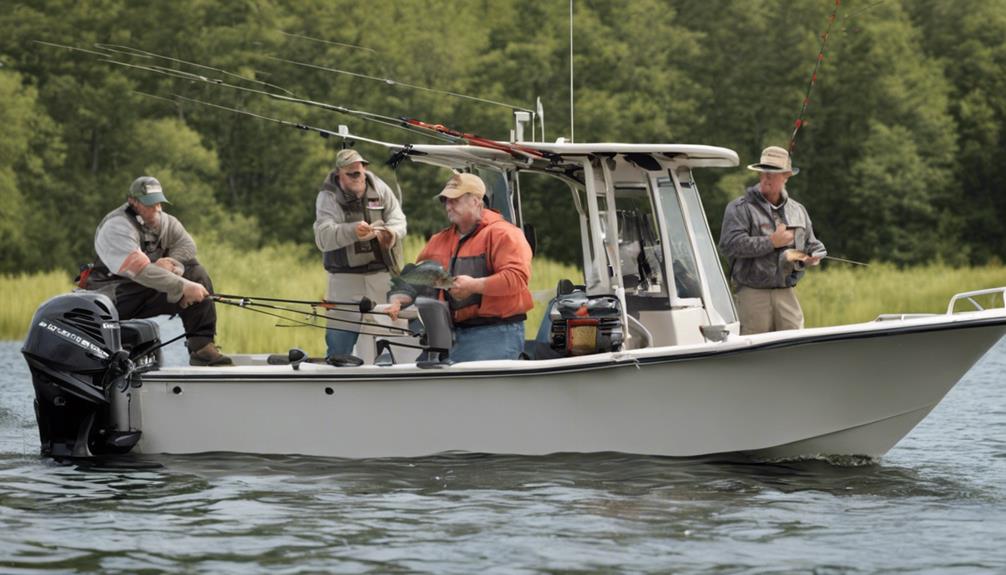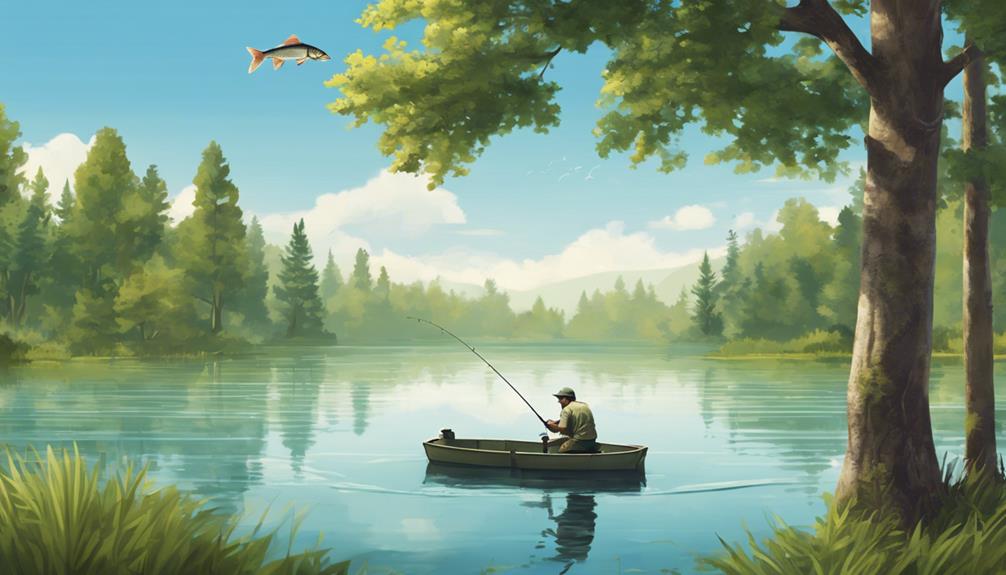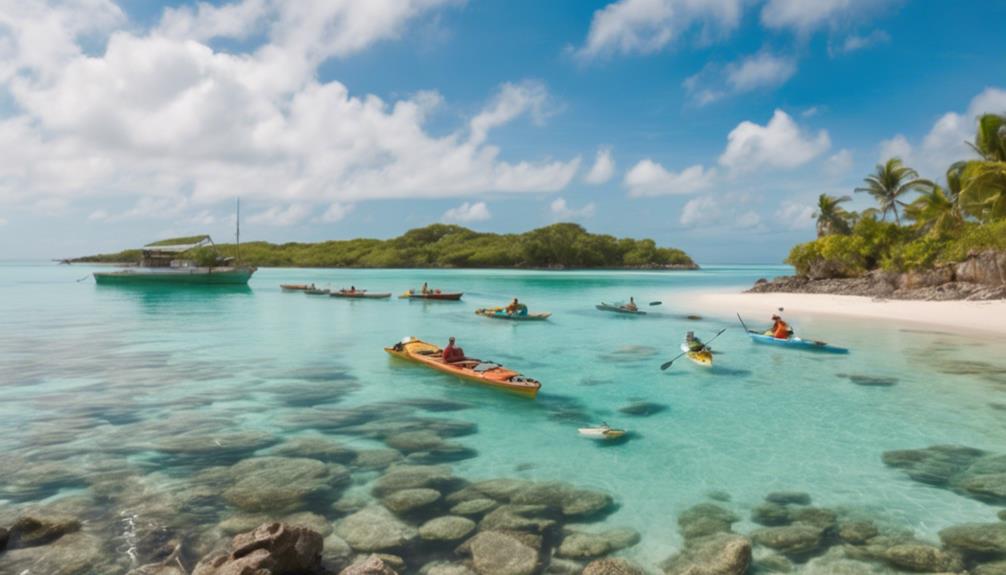By delving into the waters with your fly rod, you not only partake in a beloved pastime but also contribute to a vital environmental cause.
The art of fly fishing holds a key to unlocking a myriad of conservation advantages that reverberate beyond the riverbanks. From fostering sustainable recreation practices to actively engaging in habitat preservation efforts, the impact anglers can have on ecosystems is profound.
The intricate dance between angler and fish offers a unique perspective on conservation that goes far beyond the surface.
Fly Fishing as Sustainable Recreation
When fly fishing, you can actively engage in sustainable recreation practices that benefit the environment. Environmental stewardship is at the core of fly fishing, promoting ethical angling practices that prioritize the well-being of aquatic ecosystems. By practicing catch and release, using barbless hooks, and minimizing your impact on the environment, you contribute to biodiversity conservation and responsible recreation.
Fly fishing enthusiasts often adhere to a strict code of conduct that emphasizes respect for nature and its inhabitants. This commitment to ethical angling involves minimizing stress on fish, handling them with care, and releasing them back into the water unharmed. Such practices not only ensure the survival of fish populations but also uphold the delicate balance of aquatic ecosystems.
In addition to ethical considerations, fly fishing promotes biodiversity conservation by supporting healthy fish populations and preserving natural habitats. By practicing catch and release, anglers help maintain genetic diversity within fish stocks and prevent overexploitation of vulnerable species. Responsible recreation extends beyond catching fish to appreciating the beauty of nature, fostering a deeper connection to the environment.
Habitat Preservation by Anglers
Anglers play a crucial role in preserving habitats through their conservation efforts and stewardship practices. By engaging in angler education programs, individuals can learn about the importance of habitat preservation and restoration. These initiatives aim to raise awareness about the fragile ecosystems that support fish populations and promote responsible angling practices to minimize environmental impact.
Through habitat restoration projects, anglers actively contribute to the improvement of aquatic environments. By participating in initiatives such as stream clean-ups, riparian reforestation, and invasive species removal, anglers can help restore habitats crucial for fish breeding, feeding, and shelter. By understanding the specific needs of different fish species and their habitats, anglers can make informed decisions to protect these environments for future generations.
Anglers also have the opportunity to engage in habitat preservation through advocacy and community involvement. By supporting local conservation organizations and participating in habitat protection campaigns, anglers can amplify their impact and contribute to larger-scale conservation efforts. By working together with other stakeholders, including government agencies and environmental groups, anglers can ensure the long-term sustainability of fish habitats and promote biodiversity conservation.
Catch-and-Release Practices
To further enhance your conservation efforts as an angler, let's focus on the sustainable practice of catch-and-release. By practicing catch-and-release, you play a crucial role in ensuring fish welfare and promoting ethical angling practices. When you catch a fish and release it back into the water, you give it a chance to survive and reproduce, contributing to the sustainability of fish populations.
Fish welfare is a key consideration in catch-and-release practices. Handling fish properly, using barbless hooks, and minimizing fight time are essential for ensuring the fish's well-being. By following these guidelines, you can reduce stress on the fish and increase its chances of survival after being released.
Ethical angling practices involve treating fish with respect and care, recognizing their importance in the ecosystem.
Restoration of Fish Populations
Engaging in habitat restoration projects can significantly contribute to the recovery of fish populations. By restoring degraded habitats, you provide essential breeding grounds and shelter for fish species. This restoration effort plays a crucial role in enhancing genetic diversity among fish populations. Genetic diversity is vital for ensuring the resilience and adaptability of fish species to changing environmental conditions.
Additionally, restoring habitats can facilitate fish migration, allowing them to move freely between different habitats for feeding, breeding, and seeking refuge. Monitoring fish populations is essential to track the effectiveness of restoration efforts. Population monitoring helps in understanding the trends in fish populations, identifying any potential threats, and implementing necessary conservation measures.
Restoration projects can focus on improving water quality, reestablishing riparian vegetation, removing barriers to fish movement, and enhancing spawning grounds. These efforts create a more suitable environment for fish to thrive, leading to an increase in their numbers over time. By actively participating in habitat restoration initiatives, you directly contribute to the preservation and recovery of fish populations in rivers, lakes, and streams. Your involvement can make a significant impact on the overall health and sustainability of aquatic ecosystems.
Reduction of Invasive Species
By actively participating in efforts to reduce invasive species, you can help protect native fish populations and preserve the ecological balance of aquatic ecosystems. Invasive species control is crucial for maintaining the environmental integrity of aquatic habitats. These non-native species often outcompete native fish for resources, disrupt food chains, and alter the natural ecosystem balance. Through invasive removal initiatives, such as manual removal or introducing natural predators, you can contribute to restoring the health of aquatic environments and safeguarding the biodiversity of native fish species.
The environmental impact of invasive species extends beyond just the aquatic realm. When invasive species proliferate unchecked, they can also harm terrestrial habitats connected to water bodies. By combating invasive species through targeted strategies, you not only protect aquatic ecosystems but also mitigate the cascading effects on surrounding environments. This integrated approach to species control helps maintain the delicate balance of entire ecosystems, ensuring the long-term sustainability of native fish populations.
Your involvement in invasive species management through activities like habitat restoration, monitoring programs, and public awareness campaigns plays a vital role in safeguarding the natural heritage of aquatic ecosystems. By understanding the importance of invasive species control and actively participating in conservation efforts, you can make a tangible difference in preserving the ecological integrity of our watersheds.
Support for Local Ecosystems
In actively supporting local ecosystems, you play a crucial role in preserving biodiversity and maintaining environmental balance. By engaging in fly fishing practices that prioritize the well-being of the local flora and fauna, you contribute to the enhancement of biodiversity within the ecosystem. Your efforts help ensure that various species can thrive and coexist harmoniously, creating a balanced and resilient environment.
In addition to directly impacting biodiversity enhancement, your support for local ecosystems can also involve forming valuable environmental partnerships. Collaborating with local conservation organizations, government agencies, and other stakeholders allows for the sharing of knowledge, resources, and strategies aimed at protecting and restoring the ecosystem. These partnerships enable a more comprehensive and effective approach to conservation, leveraging collective expertise and support for the benefit of the environment.
Through your dedication to supporting local ecosystems, you actively participate in the preservation of natural habitats and the promotion of sustainable practices. By valuing and safeguarding the diverse array of plants, animals, and ecosystems in your region, you help maintain the delicate balance of the environment. Your commitment to biodiversity enhancement and environmental partnerships is essential for the long-term health and stability of the local ecosystem.
Community Involvement in Conservation

Actively involving your community in conservation efforts enhances the collective impact on local ecosystems and biodiversity. By fostering volunteer initiatives and grassroots support, you can significantly contribute to the preservation of natural habitats and wildlife populations.
Here's how you can effectively engage your community in conservation:
- Organize Cleanup Events: Encourage community members to participate in local cleanup initiatives to remove litter and debris from waterways and surrounding areas. These events not only improve the aesthetic appeal of the environment but also prevent pollution from harming aquatic life.
- Educational Workshops: Host informational workshops to raise awareness about the importance of conservation and sustainable practices. By educating your community about the benefits of protecting natural resources, you can inspire individuals to take action and make environmentally conscious decisions.
- Collaborate with Local Organizations: Partner with environmental groups, schools, and businesses to coordinate conservation projects and initiatives. By working together, you can leverage collective resources and expertise to implement meaningful conservation strategies that benefit the entire community.
Through active participation in volunteer initiatives and garnering grassroots support, you can mobilize your community to play a crucial role in safeguarding the environment for future generations.
Advocacy for Clean Waterways
Engage your community in advocating for clean waterways to protect the local environment and preserve aquatic ecosystems. Water quality is essential for the health of aquatic life and overall ecosystem balance. By actively promoting the importance of clean water, you can contribute to environmental protection efforts in your area.
Start by organizing community clean-up events along rivers, lakes, and streams. Encourage local residents, schools, and businesses to participate in these initiatives to remove trash and pollutants from waterways. By taking direct action to improve water quality, you can make a tangible difference in preserving the natural beauty of your surroundings.
Raise awareness about the impact of pollution on aquatic ecosystems. Use social media platforms, local newspapers, and community events to educate others about the importance of clean water for fish, plants, and wildlife. By sharing information about the benefits of environmental protection, you can inspire more people to join the cause.
Collaborate with local authorities and environmental organizations to advocate for policies that prioritize water quality. Support initiatives aimed at reducing runoff pollution, implementing water treatment technologies, and enforcing regulations to prevent contamination. By working together with key stakeholders, you can amplify your advocacy efforts and make significant strides towards cleaner waterways.
Frequently Asked Questions
What Are Some Common Fly Fishing Techniques and Gear That Can Help Minimize Impact on the Environment?
When fly fishing, remember to prioritize sustainable practices and ethical angling techniques to minimize impact on the environment. Choose eco-friendly gear and support conservation efforts whenever possible.
How Can Fly Anglers Contribute to the Protection of Sensitive Habitats Beyond Catch-And-Release Practices?
To protect sensitive habitats beyond catch-and-release, fly anglers can engage in habitat preservation through community partnerships. By collaborating with local organizations, you can contribute to conservation efforts and promote sustainable practices.
Get involved in restoration projects, educate others on the importance of preserving habitats, and support initiatives that aim to protect ecosystems for future generations.
Together, anglers can make a significant impact on safeguarding our environment.
Are There Any Specific Fish Species That Benefit the Most From Restoration Efforts by Fly Fishers?
Certain fish species benefit the most from restoration efforts by fly fishers. Through conservation benefits, native species like cutthroat trout and brook trout thrive.
Restoration success in their habitats improves the ecological balance, ensuring these species can flourish. By focusing efforts on these specific fish populations, fly anglers can make a significant impact on preserving and enhancing the biodiversity of delicate aquatic ecosystems.
How Can Fly Fishing Help Control Invasive Species in Waterways?
To control invasive species in waterways, fly fishing can play a vital role. By targeting specific invasive species during fishing trips, you can help reduce their populations.
Additionally, habitat restoration efforts carried out by fly fishers can create healthier ecosystems, making it harder for invasive species to thrive.
Through these conservation practices and community engagement, fly fishing enthusiasts can actively contribute to the preservation of native species and the overall health of aquatic environments.
What Are Some Lesser-Known Ways That Fly Anglers Can Support and Enhance Local Ecosystems Through Their Activities?
To support and enhance local ecosystems, fly anglers can engage in habitat restoration projects and work with conservation partnerships. By actively participating in community engagement initiatives, you can contribute to improving water quality and protecting natural habitats.
Collaborating with local organizations can help raise awareness about conservation efforts and ensure the sustainability of ecosystems for future generations. Join forces with others who share your passion for preserving the environment through fly fishing.
Conclusion
By participating in fly fishing, you aren't just enjoying a recreational activity, but also contributing to conservation efforts. Your catch-and-release practices, support for local ecosystems, and advocacy for clean waterways all play a vital role in preserving our environment.
Together, anglers can make a significant impact in protecting and restoring fish populations, habitats, and overall biodiversity. Keep casting your line and making a positive difference for future generations to enjoy.



